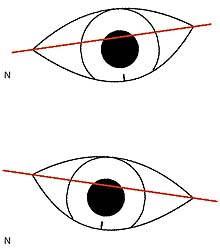Study results show that lid topography can predict soft toric lens fit
As contact lens practitioners, we are always seeking ways to streamline our fitting and increase our success rates. Some new advances in the technology help us, and some new advances make things more difficult (bifocals, anyone?). Within the past year, one particular study has aided my understanding of the way soft toric lenses fit: Young G, Hunt C, Covey M. Clinical evaluation of factors influencing toric soft contact lens fit. Optom Vis Sci. 2002;79(1):11–19.
In this study, the authors explored predictive factors for soft toric fitting. More specifically, they attempted to shed some light on what we all strive for when fitting torics: the goal of no rotation. These researchers took a different approach to the problem. The idea was to look carefully at the lid anatomy and come up with configurations that can be correlated to rotation.
Unfortunately for us as practitioners, we are unable to easily redesign a patient’s lids for the sake of stabilizing a lens. Luckily, the authors provide guidelines to follow so we can predict how a lens will orient according to lid configuration.
Prism ballasted back surface torics
The work in this study is based on prism ballasted back surface toric designs. It is a good choice, because most torics today are made of this design, which is also my personal preference. I find prism ballasted back toric designs more stable and reliable than dynamic stabilization back toric designs.
The authors looked at numerous variables in 45 subjects. Several of these factors were related to lid topography: horizontal angle, intercanthal angle, angle of central upper lid, angle of nasal upper lid, angle of temporal upper lid, angle of central lower lid, angle of nasal lower lid, angle of temporal lower lid, inferior nasal aperture, palpebral aperture and superior temporal aperture. As one can see, almost every imaginable angle and aperture related to lid geometry was measured.
What were the conclusions? The researchers established the effect of lid incline. An intercanthal angle of greater than 5° can indicate increased inferior-temporal lens orientation. A negative intercanthal angle can indicate inferior-nasal orientation. In simple terms, when the outer canthus is higher than the inner canthus, the lids slope downward toward the nose, and the lens will rotate temporally. When the outer canthus is lower than the inner canthus, the lids slope away from the nose, and the lens will rotate nasally.
|
|
Nasal kick
Many of us were taught to expect nasal rotation when fitting lenses for astigmatism. For front surface toric rigid gas-permeable (RGP) lenses and RGP prism ballasted bifocals, many fitters automatically build in a compensation for nasal rotation. Sometimes, this effect is referred to as “nasal kick.” It allows for 15° of nasal rotation in each eye. The assumption is based on previous experience with the forces related to blinking.
This new study shows that nasal rotation will not always occur. A look at the lid geometry can give us an idea of which way the lens will rotate.
The researchers also established the effect of palpebral aperture size. Many fitters assume that small aperture sizes are usually associated with tight lids and unpredictable lens rotation, which is due to the excessive force on the lens exerted by the lids. This study shows quite the opposite to be true. Small aperture sizes are associated with more stable lens orientation.
The smaller aperture indicates greater surface area contact between the lids and the lens. The greater the surface contact, the more influence the lids have on the orientation. This, in turn, increases the “watermelon seed” effect and allows better stabilization. Larger diameter soft torics are known for offering superior stability. Increased lid contact can be achieved with either a smaller palpebral aperture or a larger diameter lens.
The new information from this study offers greater insight into rotational movements. We can now make more reasonable pre-fitting decisions based on lid incline and palpebral aperture size. It is hoped that this knowledge will better enhance our soft toric lens fitting.

